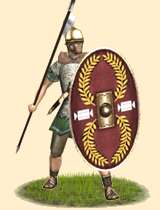Cohors Validvm Avxiliarivm (Imperial Heavy Auxiliary Infantry Cohort)
 |
Weapons | Defence | Mental | ||||||
|---|---|---|---|---|---|---|---|---|---|
| Primary | Secondary | Armour: | 10 | Morale: | 11 | ||||
| Type: | spear | none | Shield: | 3 | Discipline: | disciplined | |||
| Attack: | 14 | 0 | Skill: | 8 | Training: | highly_trained | |||
| Charge: | 4 | 0 | Recruitment | Other | |||||
| Lethality: | 0.13 | 0.1 | Soldiers: | 50 | Hit Points: | 1 | |||
| Range: | 0 | 0 | Cost: | 1619 | Mass: | 1.15 | |||
| Ammo: | 0 | 0 | Upkeep: | 405 | |||||
| Turns: | 1 | ||||||||

A heavy auxiliary infantry cohort fights as heavy spearmen in close formation similar to the legionary infantry, but without their tactical flexibility. However the auxiliaries hastae give them a better defence against cavalry attacks.
Soldiers for the auxiliary cohorts can be drafted into the army in all provinces of the Imperium Romanum.
Auxiliary infantry is a cheaper supplement of the legionary troops and a good way to better participate the provinces at the huge burdens of the empire to defend its people. The soldiers in most of these cohorts fight as heavy spearmen in close formation similar to the legionary infantry, but without the tactical flexibility offered by their larger scutum and the pilum. However other than the pilum the hasta, commonly used by the auxiliaries, is a true thrusting spear and as such a better defence against cavalry attacks. Other than the hasta they are equipped with the gladius, long flat mostly oval shields and well protected by shirts of lorica hamata (chain mail) and old style bronze montefortino helmets, often out phased from the legions.
Historically, after his final victory in the civil war when he formed the standing army of the Principate, Augustus vastly decreased the numbers of legions from over forty to a necessary minimum strength of 28. However to observe and garrison the sheer endless borders of the Imperium Romanum, much more and cheaper troops were needed. Subdued tribes and states always had to supply the Roman army with soldiers and around 50% of its soldiers were at all times not Roman citizens. The empire continued this practice. To increase their efficiency and ease the cooperation with other parts of the army most of these troops were organized into cohorts with roman command structure and training. During the following decades of Augustus rule, the imperial army changed significantly. In many fields a systematic approach replaced the improvisation of the late republican era. Most important was that the auxilia, with its indispensable cavalry and archer units, became a regular arm of the professional army and its second base.
The ordinary infantry of the auxilia received less pay and their equipment was often of inferior quality than the legionnaires’. Their cohorts made the bulk of the auxilia and were ranked lowest of all regular units of the imperial army. These infantry units were a cheap supplement to the legionary infantry and relieved them from secondary tasks, as garrison duties, border patrols, the protection of missile troops on the battlefield or to hold less important sections of the battle line. Their soldiers were equipped in the Roman fashion, and well commanded first by proven Centurions, transferred from the legions and later by a corps of equestrian officers. They were now mostly directly recruited from amongst the peregrines, free provincials without roman citizenship, in Romanized areas who either volunteered for service or accepted a draft into it. However, the transformation of the auxilia did not happen over night and the irregular contingents of soldiers supplied by allied tribes and vassal states did not disappear all at once. While the large majority of the alae (pure cavalry units where the need for regular forces was more urgent) were reorganized during Augustus reign, the infantry followed much more slowly, lingering in the old fashions until the later years of the 1st century AD.
Most cohorts of the Principate’s auxilia were standard sized cohors quingenaria units, consisting of 480 enlisted soldiers organised in six centuriae. Later in the first century elite approximately double strength cohors millaria and mixed cohors equitata appeared. The equitata units had their own attached cavalry contingent of 120 respectively 240 troopers for the millaria version, so that these units could either operate independently without further assistance or provide a more flexible support for the legions in the case of specialised archer units. Normally the cohorts were named after the ethnicity of the original recruits and kept their name even if they were transferred to other parts of the empire where they immediately begun to recruit locals as replacement.
The length of service for all soldiers was finally set to 26 years for fleet soldiers, 25 years for soldiers of the auxilia, 20 years for legionnaires, and 16 years for praetorians. After their discharge they received a cash bonus, the praemia militare, or a small piece of land. The veterans from the auxilia and the fleet were rewarded with Roman citizenship, and a diploma to prove it. Also, medical treatment was improved and all units were now supplied with physicians.